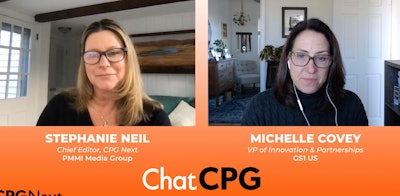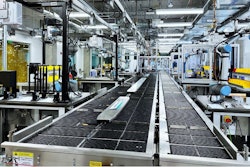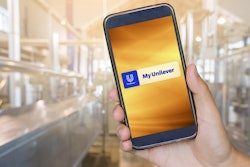
CPG Next’s ChatCPG is a 10 minute (or less) chat with a subject matter expert on all things related to CPGs on a digital transformation journey. Here, we speak with Michelle Covey, the vice president of innovation and partnerships at barcode standards organization GS1 US. The 2D barcode can hold so more information than the traditional linear barcode, opening the door to more track and trace and consumer engagement capabilities for CPG manufacturers. Scroll to the bottom to watch the interview.
Stephanie Neil: Welcome to CPG Next’s ChatCPG. These are quick 10 minute conversations with subject matter experts. And today we welcome Michelle Covey, who's the VP of innovation and partnerships at GS1. Michelle, thanks for joining me.
Michelle Covey: Thank you for having me. I'm excited to be here today.
Neil: So briefly for folks that might not know what the GS1 organization is, can you just give sort of a high level description of what it is and what you do?
Covey: Sure. So, GS1 is a global standards organization. Most people know us for the barcode and the administer of the barcode. So all of those barcodes that you see on your products that go beep at checkout, we manage the standards behind that. It's not just the barcode. We also manage a lot of business to business standards. Capturing, identifying locations and products, capturing them through barcodes to track them through the supply chain, sharing transactional information. We manage a lot of the standards, so we are a global organization. We are also represented in many of the major regions. So I represent GS1 US. There are other member organizations around the world that, serve their local regions and, yeah, we're here to help, advocate, and teach people about standards.
Neil: So why are standards so important? I mean, there's plenty of barcodes out there, but why is the standards aspect important?
Covey: It's a really good question. A lot of people always ask, you know, why, why do we have to use GS1, or why is it so important to use GS1 standards help. Businesses have an interoperable way of sharing information. So if you have a common language of business that is known around the globe, it makes it easy for one trading partner to do business with another trading partner that may have that same business requirement. So we try to take out the complexity of sharing information, making it easy to identify products globally so that they're unique. That one product can be recognized here in the United States, but it can also be recognized in Europe. It could be recognized in, in, you know, Africa and South America. It's the same product and it can be recognized globally.
Neil: Well, it's interesting too, because we recently did a story here at CPG Next on Yishi foods, which just went and got a cheap barcode somewhere and it really kind of confused the system at Whole Foods where they were selling because the barcode was associated with another product. So, it was recycled. So, I think the standards are probably important to just making sure that you don't get into a predicament like that, correct?
Covey: Exactly. So if you know, you've come to GS1 to get your product identifier, we do have a database for retailers and brands to look up that identifier, that GTIN, that we call it sometimes UPC, cause that's the barcode that we're used to seeing. Look that up into our database and it is associated to the company that actually licensed it. So, yeah, if you do go to a non GS1 source, it's not in that database, and so you can't be assured that it is associated to your product or to your company. It might be recycled, it could be counterfeit, you never know.
Neil: And quickly, define GTIN. Somebody said it to me once, the first time, and my eyes were glazed over because I didn't know what they were talking about.
Covey: Yeah, it gets used interchangeably. So GTIN is a global trade item number. It's the, you know, the acronym for that. They come in different sizes. So there's an eight digit, a 12 digit, 13 digit, and 14 digit. The 12 digit is commonly what is administered through the GS1 US. And it is associated to the UPC barcode. So that is what is encoded into the barcode. So the little numbers that you see underneath the lines, that is your actual GTIN. And that gets encoded into the barcode. In Europe, they administer the 13 digit GTINs and those get encoded into an EAN barcode. So a lot of times people use GTIN all interchangeably, but there are nuances to the definition the definition of each.
Neil: Okay. So here at CPG Next, we're all about digital transformation within the CPG industry. I get it. You know, the barcode and the standards are really important if, you know, you want to identify a product. Maybe there's a product recall. But where do you see it fitting in in the manufacturers undergoing a digital transformation? Does it have an important place there?
Covey: Absolutely. So first of all, you know, the barcode's been around for about 50 years and it was really brought to life to help with that point of sale scan. So you could do a price lookup at point of sale. I'm kind of old enough to remember when you could, they used to, you know, hand key in the prices and it would stop the line if the price wasn't associated to the product and you'd have to go do a lookup. So it really helped to automate and digitize that product or that price lookup. So 50 years, we've been doing point of sale price lookup. And that's served the industry very well, but you know, we're all carrying around a little mini-computer in our phone with a camera and companies are wanting to have more interaction with their consumers. So as we're looking to where barcodes can go in the future if that linear barcode doesn't hold a lot of information. It's really just for price lookup and industry is needing more and more information. So talking about digitizing the supply chain, having a barcode has been helpful in scanning it and being able to track it through the supply chain, but now you need more information in that barcode. You need, um, especially in a produce, in food, you need expiration dates, batch lot, especially with some of the regulations around food safety. So, it's easy. You have that scan to be able to include that into a barcode. So we're seeing an evolution from that linear barcode that we're all used to seeing into more of that 2d barcode, that QR code that we're all starting to see on our products, and that's really going to help not just consumer engagement, but so many use cases.
Neil: So let's talk about the 2D barcode again. You said it holds a lot more information. Really more consumer information like nutrition facts or, you know, traceability back to where things are grown? What are some examples?
Covey: Yes, yes, and yes. So, the great thing about the 2d barcode is it can hold a lot of different sources of information. So, some great use case we're seeing is on recall. If there is an outbreak, as some kind of food pathogen, you could trace back to the batch or back to the farm that maybe that produce came from. So you are recalling only a specific batch of that product and not taking the whole entire industry off the shelves. So product recall is a great use case. You could also link to other sources like nutritional information. Allergens, warranty information, and a consumer engagement. If you go to a product detail page, you could have consumer engagement. Maybe, you know, more of you get into the kind of augmented reality of products where you can send a consumer to a page that might give them some kind of experience with their product. So it unlocks so much potential as you move into that 2D barcode.
Neil: I keep hearing the term Sunrise 2027. Michelle, what is the industry getting ready for?
Covey: Well, Sunrise 2027 is an initiative that GS1 is undertaking to ensure that retailers are ready for bringing the capability to scan those 2D barcodes at point of sale. We're starting to see a lot more 2D barcodes on products and packages, and we're seeing some brands that are actually making that full shift. But we are looking to help support those retailers that do have the point of sale systems in place…to make sure that their systems can scan that 2D barcode. Can they handle both? Because there will be a time where there may be both, and you know, how does it handle it? Will it scan? Will it charge the customer twice? No, we've proven that out through some of these cases, but how can we ensure that industry will be ready to scan those 2D barcodes at point of sale? So that's really the initiative we're working on. And we're providing retailers with toolkits and guidance on how to get their systems ready.
Neil: Okay. And one last question. Do you envision the barcode going beyond 2D? Where do we go from here?
Covey: Yeah, It's a great question. I mean, there are other opportunities out there like digital watermarking, that sort of thing. And, you know, optical scanners can scan packages now, but really that barcode helps to really uniquely identify the product. But I think coupled with RFID, so radio frequency identification, that is a powerful tool as far as being able to not just track the product and get more product information, but then you could do other use cases such as inventory management, loss prevention, that sort of thing. So I think 2D coupled with RFID is another powerful tool that brands and retailers can take advantage of in the future. And we have some great use cases and some different opportunities where we've worked with brands where we've seen, like for example, Puma, they have implemented 2D on their products as well as RFID. So they're using that in their own private flagship stores where they're seeing the benefit to point of sale. That loss prevention. They can also start to track where that product is in the store and dwell time. They can engage the consumer in the store. So they're really seeing the unlock of both the 2D and RFID together. So, great opportunity. If anybody's in the New York area, go check out their store. It's fun. You know, we've worked with Pepsi, they’re on our board of governors, and they've talked about just how that 2D barcode is going to increase consumer engagement. But also it allows them, if there's any changes in regulation or in how to report allergens, they can quickly do that through the 2D barcode instead of having to change their packaging. And they could do it very quickly just through what they're pointing to in that 2D barcode. So, great use cases that we could provide links to that show the value of 2D and also paired with RFID.
Neil: Great. Well, for more information, people can head over to gs1us.org. And for more content like this, head over to cpgnext.com and subscribe to our weekly newsletter. Michelle, thanks for joining me today.
Covey: Thank you.
Watch the interview here:

























